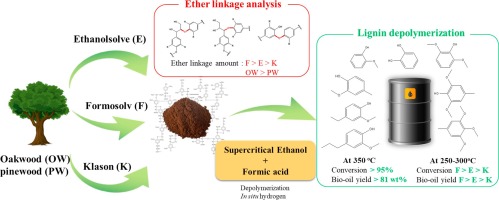Our official English website, www.x-mol.net, welcomes your
feedback! (Note: you will need to create a separate account there.)
Understanding the relationship between the structure and depolymerization behavior of lignin
Fuel ( IF 6.7 ) Pub Date : 2018-04-01 , DOI: 10.1016/j.fuel.2017.12.079 Jaeyong Park , Asim Riaz , Rizki Insyani , Jaehoon Kim
Fuel ( IF 6.7 ) Pub Date : 2018-04-01 , DOI: 10.1016/j.fuel.2017.12.079 Jaeyong Park , Asim Riaz , Rizki Insyani , Jaehoon Kim

|
Abstract Various lignin depolymerization methods have been proposed. Nevertheless, the relationship between the structure of lignin and its depolymerization behavior has not been widely investigated. Herein, six types of lignin samples were produced from oakwood (OW, hardwood) and pinewood (PW, softwood) using three different delignification techniques (ethanolsolv, formasolv, and Klason). The content of ether linkages in the OW-derived lignins was approximately three times higher than that in the PW-derived lignins because of the presence of the sinapyl alcohol unit in the former. The contents of ether linkages in the lignin isolated via the different methods followed the order: formasolv > ethanolsolv > Klason. The lignin samples were depolymerized in a mixture of supercritical ethanol (scEtOH) and formic acid at temperatures of 250–350 °C. At 350 °C, regardless of the lignin type, high conversion (>95%) and a high bio-oil yield (>81 wt%) could be achieved, demonstrating that the combined use of scEtOH-HCOOH was very effective for the depolymerization of various types of lignin. At the low temperatures of 250–300 °C, the lignin conversion and bio-oil yield were highly dependent on the amount of ether linkages; for example, at 300 °C, the use of OW-derived formasolv lignin resulted in a high bio-oil yield (86.2 wt%), whereas the use of OW-derived Klason lignin resulted in a very low bio-oil yield (27.9 wt%). The properties of the bio-oils produced from the different types of lignin were discussed.
中文翻译:

了解木质素的结构与解聚行为之间的关系
摘要 已经提出了多种木质素解聚方法。然而,木质素的结构与其解聚行为之间的关系尚未得到广泛研究。在此,使用三种不同的去木质素技术(乙醇溶解、formasolv 和 Klason)从橡木(OW,硬木)和松木(PW,软木)中生产了六种类型的木质素样品。OW 衍生木质素中醚键的含量比 PW 衍生木质素中的含量高约三倍,因为前者中存在芥子醇单元。通过不同方法分离的木质素中醚键含量的顺序为:formasolv > ethanolsolv > Klason。木质素样品在 250–350 °C 的温度下在超临界乙醇 (scEtOH) 和甲酸的混合物中解聚。在 350 °C 时,无论木质素类型如何,都可以实现高转化率 (>95%) 和高生物油产率 (>81 wt%),表明 scEtOH-HCOOH 的组合使用对解聚非常有效各种类型的木质素。在 250-300 °C 的低温下,木质素转化率和生物油产量高度依赖于醚键的数量;例如,在 300 °C 时,使用 OW 衍生的 formasolv 木质素导致生物油产量高(86.2 wt%),而使用 OW 衍生的 Klason 木质素导致生物油产量非常低(27.9 wt%)重量%)。讨论了由不同类型木质素生产的生物油的特性。证明了 scEtOH-HCOOH 的组合使用对于各种类型的木质素的解聚非常有效。在 250-300 °C 的低温下,木质素转化率和生物油产量高度依赖于醚键的数量;例如,在 300 °C 时,使用 OW 衍生的 formasolv 木质素导致生物油产量高(86.2 wt%),而使用 OW 衍生的 Klason 木质素导致生物油产量非常低(27.9 wt%)重量%)。讨论了由不同类型木质素生产的生物油的特性。证明了 scEtOH-HCOOH 的组合使用对于各种类型的木质素的解聚非常有效。在 250-300 °C 的低温下,木质素转化率和生物油产量高度依赖于醚键的数量;例如,在 300 °C 时,使用 OW 衍生的 formasolv 木质素导致生物油产量高(86.2 wt%),而使用 OW 衍生的 Klason 木质素导致生物油产量非常低(27.9 wt%)重量%)。讨论了由不同类型木质素生产的生物油的特性。而使用 OW 衍生的 Klason 木质素导致生物油产量非常低(27.9 wt%)。讨论了由不同类型木质素生产的生物油的特性。而使用 OW 衍生的 Klason 木质素导致生物油产量非常低(27.9 wt%)。讨论了由不同类型木质素生产的生物油的特性。
更新日期:2018-04-01
中文翻译:

了解木质素的结构与解聚行为之间的关系
摘要 已经提出了多种木质素解聚方法。然而,木质素的结构与其解聚行为之间的关系尚未得到广泛研究。在此,使用三种不同的去木质素技术(乙醇溶解、formasolv 和 Klason)从橡木(OW,硬木)和松木(PW,软木)中生产了六种类型的木质素样品。OW 衍生木质素中醚键的含量比 PW 衍生木质素中的含量高约三倍,因为前者中存在芥子醇单元。通过不同方法分离的木质素中醚键含量的顺序为:formasolv > ethanolsolv > Klason。木质素样品在 250–350 °C 的温度下在超临界乙醇 (scEtOH) 和甲酸的混合物中解聚。在 350 °C 时,无论木质素类型如何,都可以实现高转化率 (>95%) 和高生物油产率 (>81 wt%),表明 scEtOH-HCOOH 的组合使用对解聚非常有效各种类型的木质素。在 250-300 °C 的低温下,木质素转化率和生物油产量高度依赖于醚键的数量;例如,在 300 °C 时,使用 OW 衍生的 formasolv 木质素导致生物油产量高(86.2 wt%),而使用 OW 衍生的 Klason 木质素导致生物油产量非常低(27.9 wt%)重量%)。讨论了由不同类型木质素生产的生物油的特性。证明了 scEtOH-HCOOH 的组合使用对于各种类型的木质素的解聚非常有效。在 250-300 °C 的低温下,木质素转化率和生物油产量高度依赖于醚键的数量;例如,在 300 °C 时,使用 OW 衍生的 formasolv 木质素导致生物油产量高(86.2 wt%),而使用 OW 衍生的 Klason 木质素导致生物油产量非常低(27.9 wt%)重量%)。讨论了由不同类型木质素生产的生物油的特性。证明了 scEtOH-HCOOH 的组合使用对于各种类型的木质素的解聚非常有效。在 250-300 °C 的低温下,木质素转化率和生物油产量高度依赖于醚键的数量;例如,在 300 °C 时,使用 OW 衍生的 formasolv 木质素导致生物油产量高(86.2 wt%),而使用 OW 衍生的 Klason 木质素导致生物油产量非常低(27.9 wt%)重量%)。讨论了由不同类型木质素生产的生物油的特性。而使用 OW 衍生的 Klason 木质素导致生物油产量非常低(27.9 wt%)。讨论了由不同类型木质素生产的生物油的特性。而使用 OW 衍生的 Klason 木质素导致生物油产量非常低(27.9 wt%)。讨论了由不同类型木质素生产的生物油的特性。











































 京公网安备 11010802027423号
京公网安备 11010802027423号